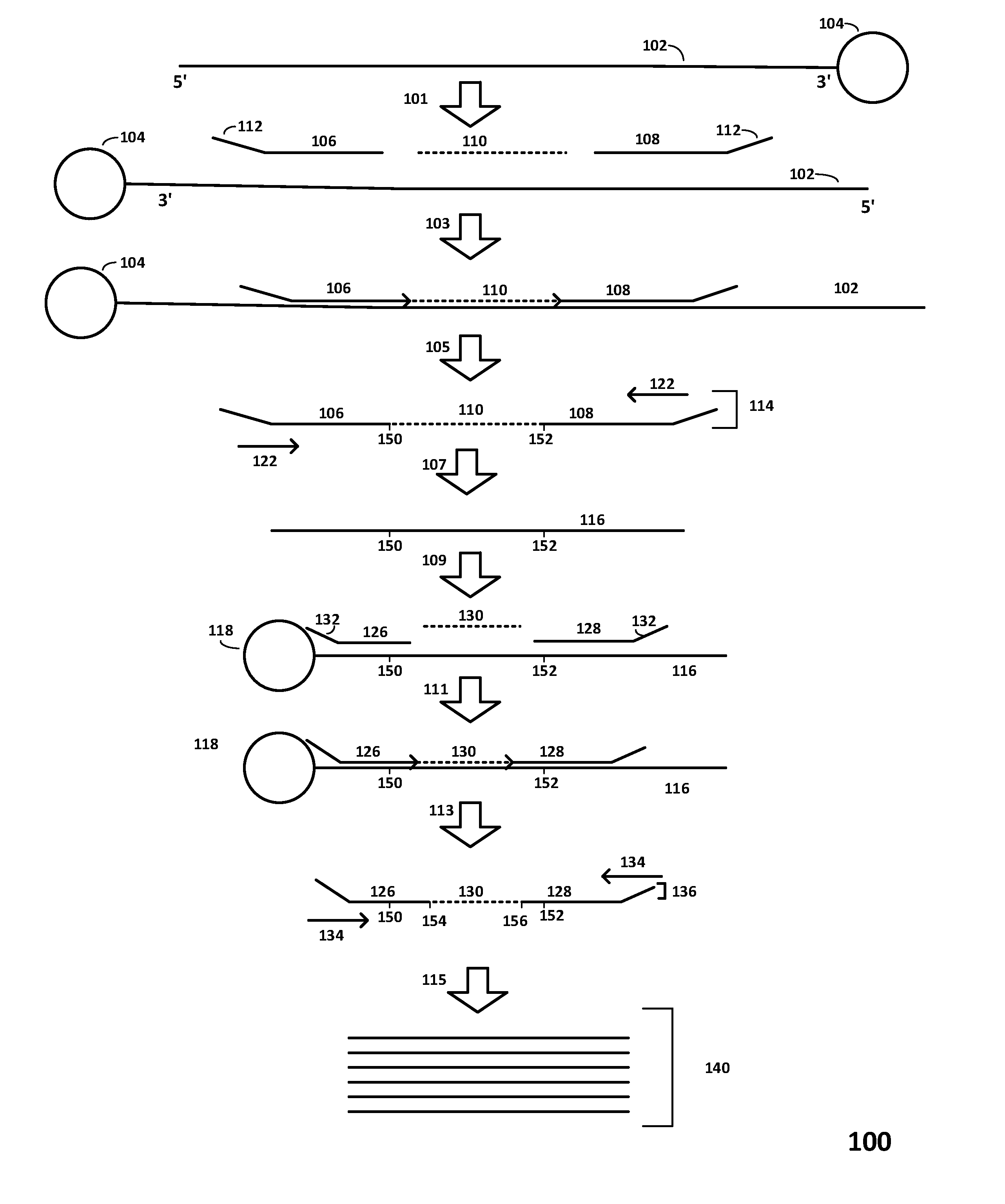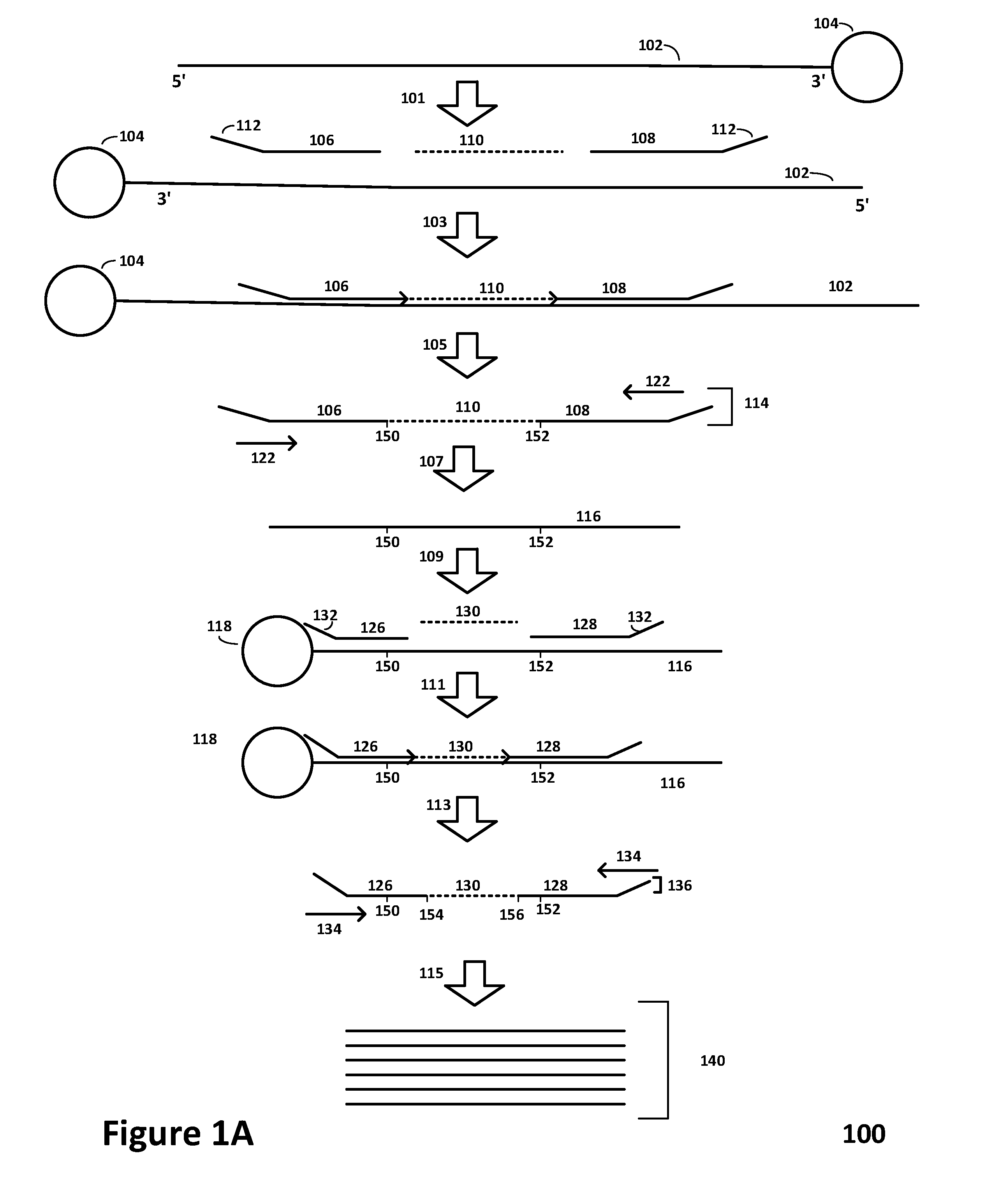Multiplexed sequential ligation-based detection of genetic variants
a technology of nucleic acid region and ligation-based analysis, which is applied in the field of multi-sequenced sequential ligation-based analysis of nucleic acid regions of interest, can solve the problems of invasive procedures and carry a risk of miscarriage of around one percent, and achieve the effect of increasing fidelity and confidence in the accuracy of genetic information
- Summary
- Abstract
- Description
- Claims
- Application Information
AI Technical Summary
Benefits of technology
Problems solved by technology
Method used
Image
Examples
example 1
Multiplexed Linear Replication (MLR) of DNA Loci
[0151]15 μl (7.5 ng) of DNA was added to each well of a 96-well plate and 30 μl of an amplification mix (5× Phusion HF buffer (Finnzymes, Espoo, Finland), 5M betaine, 25 mM dNTPs, 2.0 μM biotinylated primer and 2 units Phusion polymerase ((Finnzymes, Espoo, Finland)) was added to each well. The plate was sealed with an adhesive plate sealer, shaken at 1500 rpm for 1 min then spun for 10 seconds at 250×g using a centrifuge. Standard PCR was carried out using cycles of 95° C. for 2 minutes and 61° C. for 2 minutes.
[0152]After thermocycling was complete, the DNA was isolated from each sample, and resuspended in 30 μl TE buffer. Individual DNA isolates were transferred to a new 96-well plate.
example 2
First Round of Multiplexed Ligation-Based Analysis
[0153]10 mg of magnetic streptavidin beads (Invitrogen, Carlsbad, Calif.) was dispensed into a 15 ml conical tube and placed on a 15 ml magnetic stand. Once the streptavidin beads cleared, the supernatant was discarded. 6 ml of binding buffer (100 mM Tris pH 8.0, 10 mM Na2 EDTA, 500 mM NaCl, 58% formamide, 3.33 ng / μl yeast RNA carrier stock (Ambion, Grand Island, N.Y.) and 0.17% TWEEN™ 80) was then dispensed into the tube and 1 μg / μl per reaction of streptavidin beads were resuspended by vortexing. 1 ml of 40 nM primer pool was transferred into the 15 ml conical tube containing the 6 ml binding buffer and the tube was vortexed again.
[0154]70 μl the solution was dispensed into each well of the 96-well plate containing the eluate. The annealing reaction comprised: 1000 mM Tris pH 8.0, 500 mM Na2EDTA, 5000 mM NaCl2, 100% formamide, 1000.0 ng / μl yeast carrier stock, 10% TWEEN™ 80, and 40 nM of the primer pool. The 96-well plate was seale...
example 3
Second Round of Multiplexed Ligation-Based Analysis
[0158]10 mg magnetic straptavidin beads were dispensed into a 15 ml comical tube and placed on a magnetic stand and the solution allowed to clear. The supernatant was removed and the beads were then resuspended in 6 ml of binding buffer (100 mM Tris pH 8.0, 10 mM Na2 EDTA, 500 mM NaCl, 58% formamide, 3.33 ng / μl yeast RNA carrier stock (Ambion, Grand Island, N.Y.) and 0.17% TWEEN™ 80) was then dispensed into the tube and the magnetic streptavidin beads were resuspended by vortexing. 1 ml of 40 nM primer pool was transferred into the 15 ml conical tube containing the 6 ml binding buffer and the tube was vortexed again. 70 μl of the solution was dispensed into each well of the 96-well plate containing the eluate. The annealing reaction comprised: 1000 mM Tris pH 8.0, 500 mM Na2 EDTA, 5000 mM NaCl2, 100% formamide, 1000 ng / μl yeast carrier stock, 10% TWEEN™-80, and 30 μM of the primer pool. The 96-well plate was sealed with an adhesive ...
PUM
 Login to View More
Login to View More Abstract
Description
Claims
Application Information
 Login to View More
Login to View More - R&D
- Intellectual Property
- Life Sciences
- Materials
- Tech Scout
- Unparalleled Data Quality
- Higher Quality Content
- 60% Fewer Hallucinations
Browse by: Latest US Patents, China's latest patents, Technical Efficacy Thesaurus, Application Domain, Technology Topic, Popular Technical Reports.
© 2025 PatSnap. All rights reserved.Legal|Privacy policy|Modern Slavery Act Transparency Statement|Sitemap|About US| Contact US: help@patsnap.com



